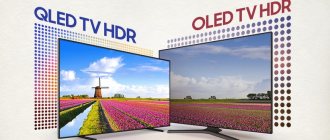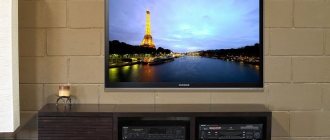For the most part, 4K/Ultra HD TVs differ from their predecessors not only in resolution and price. They have HDR support with greater color depth, higher frame rates and a dozen other features.
In this post, we tried to sort everything out and recommend several models in different price segments. And they did it traditionally without reference to our product range.
Background to 4K
In the prehistoric era of Full HD dominance—that is, five years ago—buying a 4K TV was more of an expensive, exotic experiment than a practical choice.
Apart from digital photos and handmade videos from equally expensive 4K cameras, there was basically nothing to watch. And even as a monitor for external sources of 4K images from game consoles and PCs, such a TV was of little use: mainly due to the limitations of the interfaces of that time in terms of bitrate and FPS. The collapse in prices for 4K TVs began three or four years ago, simultaneously with the advent of 4K content: movies, shows, games. By this time, the mass transition of home Internet networks at speeds of hundreds of megabits per second had successfully arrived, which in fact provided mass access to online cinemas with deposits of 4K interesting things.
Today, 4K images have completely lost their exotic status - and not only on a large home screen, but even on a smartphone display. Prices for 4K UHD TVs with a diagonal of 43 inches or more, images with ultra-high quality are easily transmitted through modern wireless networks, TV series and films are ready to be broadcast by broadcasters, Internet broadcasters and even cellular operators. 4K cameras are not built into irons.
As is the case with any other electronics, each buyer has his own preferences about the optimal diagonal, the usefulness of a particular function, and even more so about the basic budget that makes sense to spend on the purchase.
We will look at a list of basic options that you should consider before purchasing a 4K TV. What to leave on the list is up to everyone to decide for themselves. You can cross them off the list, but you probably shouldn’t ignore the entire list.
Let's figure it out: what is the difference between Full HD, Ultra HD and 4K image formats
Each of the formats has many characteristics that determine the difference between 4K, UHD, Full HD.
All symbols indicate the quality of the picture broadcast on the TV screen. Each of the formats has many characteristics that determine the difference between 4K, UHD, Full HD.
4K technology
Thinking of 4K as high-definition content is not entirely correct.
This term appeared in digital cinema, where it meant resolution. 4K is an ultra-high-definition television standard, where there are about 4000 horizontal pixels per object, that is, 4 kilos. The exact number of pixels will vary depending on the screen format. A feature of 4K is considered to be high brightness and picture clarity, which is made possible thanks to the increased frame rate. 3996 by 2160 pixels is the resolution that Ultra HD TVs have, so for consumers it is more correct to use this term when talking about the quality of television broadcasts.
Devices labeled 4K often combine HDR technology. HDR TVs offer a richer color palette, high quality screen color rendering and backlighting.
Ultra HD resolution
Equipment manufacturers consider UHD and 4K formats synonymous. By comparing them, it becomes clear what the difference is. It is Ultra HD that can be used for modern television. The abbreviation denotes a general ultra-clear broadcast standard that can be used as one of the 4K broadcast standards. The UHD label on the TV guarantees viewing of high-definition video and quality. Manufacturers are increasingly designating 4K UHD technology.
4K, Ultra HD, UHD, UHDTV, 2160p – which is correct?
4K TVs have many names, for which we have tireless marketers to thank. In fact, 4K is a picture with a size of 4096x2160 pixels, that is, a format accepted in the film industry and does not quite correspond to the resolution and format of the television.
Comparison of different screen resolutions
On TVs, the picture has a different size - QuadHD, 3840 x 2160 pixels, or 2160 lines (lines - 2160p). By the way, this is exactly twice as large (both vertically and horizontally) than the Full HD standard (1920 x 1080), or four times in area. That is, it is about 8 million pixels versus 2 million for Full HD. The term “4K” is short and succinct, it turned out to be very convenient for advertising, and it has stuck.
Ultra HD (Ultra High Definition TV), UHD, UHDTV are all different names for the new “ultra high quality” TV standard versus HDTV (High Definition TV), which corresponds to Full HD quality.
UHD 4K TVs – pros and cons
Since we already know what we're dealing with, it's worth thinking about how this technology affects the quality guaranteed by the latest TVs.
One of the most important advantages of a 4K image is, of course, the higher resolution compared to the previous standard, that is, Full HD (1920x1080). The number of lines has been doubled both vertically and horizontally, allowing you to squeeze in 4 times more pixels. Thanks to this, the image becomes clearer and more detailed. This is especially noticeable when playing materials prepared specifically for 4K resolution.
Of course, most TVs also support upscaling features, meaning they "enhance" lower-resolution images, but you can see true quality by watching 4K movies or playing the latest games.
With the increase in resolution, it was also proposed to increase the video playback speed. 4K supports the ability to generate images from 24 to 120 frames per second.
There are, of course, more benefits to using UHD 4K TVs - many of them are not related to the quality of the image itself. It should be emphasized that these types of devices are often equipped with many additional functions. Most of them are smart TV models that allow you to install many applications (eg Netflix, Twitch). In addition, there are various technologies that enhance the capabilities of the TV.
Of course, this doesn't mean that these devices don't have their drawbacks. As it turns out, cheap 4K TVs are bad at displaying moving images in dynamic scenes, which Full HD devices do very well. This is due to a decrease in the image refresh rate. Therefore, you should not buy models below the middle class - it would also be a good idea to analyze various tests and reviews of the equipment you are interested in.
Until recently, the downside of 4K TVs was the limited amount of footage available, both in film and television. However, the situation is changing dynamically, as evidenced by streaming services such as Netflix. More and more new films and TV series support this resolution, so you should not have problems finding interesting materials.
The same applies to games - 4K support is provided by new projects on both the PlayStation Pro 4 and Xbox One X. More and more television stations are also using this technology.
TV specifications
4K TVs of the first generations and a number of modern budget models are capable of reproducing a color palette with a depth of 8 bits per color, which is a total of 16.7 million colors.
The UHDTV standard initially included not only a purely “mechanical” increase in picture resolution (4K, and in the next few years - already 8K), but also a number of other important characteristics. Since we are going to make a “cinema at home”, why not build on the standards of cinema, and then, perhaps, even surpass them? For reference: the basic requirements of the main Ultra High Definition TV standard (Rec. ITU-R BT.2020) imply that by 2020 UHD TVs (with 4K picture and in the future 8K will support scanning up to 120 frames per second, 10-bit and in the future, even 12-bit color coding (HDR and its further development), as well as spatial sound with up to 24 channels!
Color depth
Compared to previous Full HD (HDTV) TVs, 4K models, first of all, increase the supported color depth - at least to 10 bits per channel. For modern 4K TVs, this means the ability to display about 1.07 billion RGB colors.
Comparison of the color gamut of Full HD and 4K/UHDTV TVs
This ensures support for High Dynamic Range (HDR), displaying a huge number of color gradations - the smallest shades of light tones and shadows in the dark.
HDR
The basic characteristics of a television HDR image are laid down in the above-mentioned Rec.
ITU-R BT.2020, although currently content and technology producers are gradually mastering the new BT.2100 standard adopted in 2021. In particular, the Rec. 2100 defines three picture resolutions: 1080p (Full HD), 3840 x 2160 (this is what we call “4K”) and 7680 x 4320 (future “8K”); all three have square pixels and a 16:9 aspect ratio. List of supported Recs. 2100 frame rates include 120p, 119.88p, 100p, 60p, 59.94p, 50p, 30p, 29.97p, 25p, 24p, 23.976p. As you can see, we are talking only about progressive scanning (p - progressive), the antediluvian interlaced (i - interlaced) options are finally written off as scrap.
Rec. 2100 specifies a color sampling depth of 10 or 12 bits.
From a practical standpoint, remember that Rec. 2100 defines exactly the same color space as Rec. 2020. This, in turn, is significantly wider than the sRGB color space, which uses the primary colors of the previous BT.709 standard. It is also worth noting that the wider AdobeRGB gamut, originally developed by Adobe on the basis of sRGB to cover the entire printed color gamut of color printers in the CMYK color model, is also a subset of the Rec. 2020/2100.
Comparison of color spaces DCI-P3 (digital cinema), AdobeRGB, Rec. 709 (sRGB) and Rec. 2020/2100
However, head-to-head comparisons of HDR in cameras, camcorders and televisions are still not entirely appropriate, if only because working with extended dynamic
range, when forming and processing a video stream, many additional parameters are used to ensure stability of brightness and color reproduction over time. It was these nuances, in particular, that led to the emergence of the new Rec standard. 2100.
Comparison of standard and high dynamic range
Actually, the key difference between Rec. 2021 and BT.2100 is that the newer version of the standard works with two basic versions of high dynamic range (HDR), defined by different techniques for its formation.
Visual difference between a regular picture and an HDR image
Perceptual Quantization (PQ) to display High Dynamic Range (HDR) video with brightness levels up to 10,000 nits in the Rec.2020 color space
— industrial standard SMPTE ST 2084.
The PQ technique is the basis of today's popular open formats HDR10 (combination with static metadata for color gamut correction) and HDR10+ (dynamic metadata for frame-by-frame brightness adjustment), as well as the private closed format Dolby Vision (Rec.2020 color space, but with 12-bit color depth in combination with static and dynamic metadata).
Comparison of images with normal gamma and HDR+ on Samsung TVs
This technique already has wide support from both TV manufacturers (LG, Samsung) and content producers (Netflix, Amazon). In fact, the new ITU standard does not affect PQ technology in any way.
4K/Ultra HD HDR logo
An alternative to PQ is HLG (Hybrid Log-Gamma)
- is interesting in that due to the hybrid gamma curve (the lower part of the signal values according to the gamma curve, the upper part of the signal values according to the logarithmic curve) it ensures compatibility with standard (SDR) dynamic range images. In other words, by combining SDR and HDR picture information into a single signal, HDR TVs with HLG can extract the data they need for extended dynamic range, while conventional SDR TVs simply ignore it.
HLG support is not yet comparable in prevalence to the PQ format, although it is included in the DVB standard ATSC 3.0, ITU Rec. 2100, as well as HDMI 2.0b, HEVC, VP9 and H.264/MPEG-4 AVC specifications. However, a number of content producers and some TV networks (BBC iPlayer, DirecTV, Freeview Play, YouTube) have already announced plans to adapt HLG. TV manufacturers, in turn, are trying to provide HLG support on their existing fleet of commercial HDR TVs by releasing updated firmware.
Frame rate, FPS
The higher the supported frame rate, the less blur you'll see in super-sharp images when watching fast-paced content like sports and games.
What's the point of buying a 4K TV if the picture is constantly blurry due to low FPS? The first 4K TVs initially had frame rates of less than 60 frames per second. Now, within the framework of the new standards, we are talking about 120 frames per second.
Diagonal
A 4K image on a medium-sized screen, when viewed from several meters away, is perceived by many viewers as a 3D image.
However, the difference will be noticeable if you watch a 60-80 inch 4K TV from a sofa five meters from the screen or from a meter away - for example, with a game console. As with conventional TVs, there is no single recipe for choosing a diagonal. While something is more appropriate in the kitchen or bedroom, the choice will be different for a home theater in the living room. You can start from the criteria for evaluating the “retina” of smartphones: diagonal in combination with the distance to the screen.
Sound
Supporting all 24 audio channels according to the UHDTV standard is still a long way off for everyone - broadcasters, film producers, games, and, in fact, televisions.
However, seven or more audio channels are no longer uncommon on modern 4K TVs. In most cases, this is 2-, 5.1-, or 7.1-channel audio, although often the TV will interpolate multi-channel surround sound from the normal stereo input signal. Perfectionist audiophiles are unlikely to be interested in the sound placed inside thin television panels. However, today on sale you can find TVs with real miracles of acoustic engineering - subwoofers and speakers with ribbon and spatial radiators with excellent sound are built into panels a few millimeters thick. As a rule, in this case we are talking about premium segment TVs.
Screen type: OLED, QLED, IPS, TN?
OLED TVs are still the leaders in the premium segment, and this is not surprising given their “instant” response speeds, hundreds of times faster than the best LED models, as well as true-to-life blacks and a huge color gamut.
Quantum Dot technology - QD LED (QLED in Samsung terminology) is an LCD panel with semiconductor nanocrystals that glow under the influence of current or light. Compared to OLED screens, QLED displays are said to have a longer lifespan and are also somewhat more affordable than OLED models today, although they are also in the premium price range.
If we are not talking about the latest OLED and QLED TVs with exorbitant price tags, manufacturers do not always indicate the type of matrix in a specific TV model: LCD and that’s it. In addition, modern algorithms for internal intermediate image processing process the signal quite powerfully. After these “improvers,” and even in combination with various types of backlights and their dimming, it is not yet a fact that you should rely on a specific type of matrix.
That is why, having read various pros and cons on the Internet, it makes sense to go to the nearest store or demo center and trust your own eyes the old fashioned way: seeing it once is better than hundred hundred reviews on the Internet, fact.
Smart TV
For a long time, televisions were called “television receivers”: by analogy with a radio receiver, they could only receive an over-the-air signal.
First, the TV was connected to a VCR, then digitally to a PC, DVD and flash players. Finally, televisions have learned to connect to the Internet, independently receive and decode terrestrial, satellite and cable TV channels, record them and provide delayed viewing of programs.
For the owner of a 4K TV, the presence of the Smart TV function means unhindered access to one or another UHD content, and in the case of TVs from some large companies - such as LG, Samsung, Sony, Panasonic, Philips, also to free collections of 4K films and programs through direct cooperation between TV and content producers. Moreover, some companies even organize online premieres of films almost simultaneously with the start of their theatrical release.
You can also always use the services of numerous online cinemas. Some of them now offer 4K content even with HDR support. Finally, you can always buy an external TV set-top box.
But before purchasing, especially a budget 4K TV, just in case, it’s worth finding out whether it (and what type) has built-in Wi-Fi, a webcam, and whether these options can be purchased in our country. Modern Smart TVs typically use the Android platform or the company's own OS, but most of them support the ability to install online services and movie theaters. The best ones also support gesture and voice control, technology for interacting with mobile devices and duplicating the smartphone screen onto the TV screen.
Some companies, such as Samsung, are also releasing 4K TVs with the ability to add support for the requirements of new UHD standards without having to replace the entire TV.
Go to the store or buy online?
Online offers tend to have more attractive prices, and there is always more choice.
If you have clear confidence in your choice and don’t have time to run around, why not, as long as it comes with a reasonable delivery price and all the documents and guarantees. But it’s better to do the opposite - find the optimal model on the Internet (preferably several), and treat yourself to a trip to the store for a “bride.” TV in the picture and “live” in work are two completely different things. In reality, you may not like the design, the remote control, the quality - but you never know.
Having decided on the maximum purchase amount, add at least 20% to it in order to be prepared for surprises, pleasant and not so pleasant. For example, in order not to miss an unexpectedly profitable offer when, along with the planned TV, you will get some nice bonus in the form of external acoustics almost free of charge.
For audio and video perfectionists, lovers of techno-exotica or huge diagonals, and finally, for those with tight wallets, among the newest TVs of the season there is always something special: with an exclusive design, a curved or stereoscopic 3D screen, with an OLED matrix or “quantum dots”, multichannel sound and so on.
Budget 4K
Incredibly, today for just $500 or less you can buy an excellent 4K TV with a diagonal of 43 inches or more. There is nowhere more budget-friendly.
TV LG 43UJ631V-ZA
Now in retail you can find modern 4K TVs - such as, for example, the 43-inch LG 43UJ631V-ZA or Samsung UE43MU6100U, which provide HDR support and a set of Smart TV functions at a price of about 30 thousand rubles.
TV Samsung UE43MU6100U
To be fair, it should also be noted that if you want, you can find a 4K TV even cheaper - about 25 thousand rubles or even a little less. We are talking about models from brands such as BBK, Daewoo, Haier and others. Here, rather, along with the ratio of price and set of (lack of) functions, one must also take into account factors of trust in the brand and warranty.
49.5-inch TV BBK 50LEX-6027/UTS2C (23 thousand rubles)
And, of course, don’t forget about Smart TV: if it’s Android, there won’t be any problems, if it’s something of the company’s own, it’s better to check in advance whether the TV supports installation of the services and applications you need.
Returning to models in the price range of the conditional “500 euros” (plus or minus a couple of thousand rubles), it should be noted that if you wish, you can find very interesting 4K TV options with diagonals up to 49 inches.
49-inch TV LG 49UJ631V-ZA
For example, LG 49UJ631V-ZA - 4K, HDR, 49 inches and for only 34 thousand rubles.
40-inch TV Panasonic TX-40EXR600 (36 thousand rubles)
The favorites in the budget price segment of 4K TVs with HDR are certainly LG and Samsung, but such well-known brands as Panasonic and Toshiba also “play” here.
Middle price segment
4K TVs, with prices ranging from $500 to $1,500, are perhaps the largest and most saturated segment today, which even includes some premium QLED models. In addition, there is a great variety of TVs with huge diagonals - from 65 inches and more.
55-inch QLED TV Samsung QE55Q6FAMU
“Quantum dots” are available for about 90 thousand rubles when choosing a 55-inch TV Samsung QE55Q6FAMU.
65-inch TV LG 65UJ634V
For just over 80 thousand rubles, you can choose the huge 65-inch TV LG 65UJ634V or Samsung UE65MU6100U.
65-inch TV Samsung UE65MU6100U
If you take a closer look at the most popular models with a diagonal of 50-55 inches, you can find dozens of offers even from top brands at a price of 40-50 thousand rubles. For example, a good HDR model with a diagonal of 55 inches - LG 55UJ620V - is on sale for only 42 thousand rubles.
Curved 49-inch Samsung UE49MU6300U
It is curious that this price category also includes interesting models with a curved screen. Thus, the 49-inch Samsung UE49MU6300U can be found today at a price of only 50 thousand rubles.
What is 4K
4K – development of FullHD
4K – development of FullHD. It is distinguished by twice the length and width of the image in pixels. It received its name because of the length of the professional frame in pixels - 4096 or 4K. The 4K format is divided into 4 types:
- Full frame: 4096x3072.
- Academic: 3656x2664.
- Casketed: 3996x2160.
- UltraHD: 3840×2160.
The first 3 are used when creating and editing films. For the average user, the last type is interesting, since all 4K TVs support UltraHD.
Advantages
FullHD is gradually becoming a thing of the past and is being replaced by 4K
UltraHD TVs, which have the following advantages:
- High-quality and bright picture. This is achieved thanks to 4 times more pixels and increased color depth from 8 to 12 bits compared to FullHD.
- Increased screen refresh rate to 120 Hz. This means that the video will play smoothly, and your eyes will not get tired from watching for a long time.
- The ability to watch videos in FullHD, HD or SD quality without noticeable picture distortion. This feature is called scaling or upscaling. To do this, algorithms are used to fill the gaps with additional pixels, reducing grain and smoothing the transition from one color to another.
- The minimum distance to the device for comfortable viewing is 1.5-2 meters for models with a diagonal of 55 inches or more. This allows you to put a large TV in a small room and not worry about pixels being noticeable from a short distance.
- The format is promising. FullHD is gradually becoming a thing of the past and is being replaced by 4K. It will be relevant in 3-4 years.
- There's plenty to watch on a 4K TV. This is digital television (UltraHD package from Tricolor-TV), Youtube videos, online cinemas (Megogo, Ivi), Netflix series.
Flaws
Such devices have only one drawback - high price.
Premium Selection
The premium segment of 4K TVs (90-100 thousand rubles and above) is widely represented in Russian retail, but now the attention of connoisseurs of flagship models is focused on new products for the spring-summer 2021 season. As a rule, TV manufacturers announce new models once every six months - at the beginning of the year and on the eve of the start of the school year.
Moreover, they appear in retail at the end of spring and on the eve of Christmas sales. Today in Russian stores you can already find a unique 77-inch LG OLED77W8 TV (approximately 1.5 million rubles) from the premium LG SIGNATURE series, made on the new generation of OLED matrices, the Alpha9 intelligent processor and LG AI TV technology.
77-inch OLED TV LG OLED77W8
The LG OLED77W8 features all the latest technology developments, including support for most HDR formats, including HDR10 Pro, Dolby Vision, Technicolor Advanced HDR, HDR10 Pro and HLG Pro, as well as Dolby Atmos cinema audio technology.
Among the new 4K TVs with QLED technology for 2021, we can note the flagship Samsung Q9F with full direct backlight technology and a 75-inch diagonal. The eldest model in the series, QE75Q9FNAUXRU, supports Q HDR Elite technology (HDR 10+) and Ultra Black Elite technology with anti-reflection elements on the matrix film, which reduces light reflection and increases the contrast range.
75-inch QLED TV Samsung QE75Q9FNAUXRU
The Samsung QE75Q9FNAUXRU TV uses the new Q Engine to process and optimize complex color solutions. At retail, the new product is offered at a price of approximately 500 thousand rubles.
Among Samsung's new products there is another interesting 75-inch QLED novelty - the QE75Q8CAMUXRU model with a curved screen priced from 280 thousand rubles.
Samsung 75" Curved QLED TV QE75Q8CAMUXRU
The TV features a combination of the latest version of quantum dot technology with Q HDR 1500 wide dynamic range technology, as well as an interesting design with a smooth textured metal back panel without tangled visible wires.
Among the new premium class products, the new 4K Sony BRAVIA TVs deserve special attention - both with OLED screens and traditional LCD panels. The 65-inch model Sony KD-65AF8 with an OLED matrix at a price of about 350 thousand rubles is interesting for its high level of contrast and the ability to convey perfect black color.
65-inch OLED TV Sony BRAVIA KD-65AF8
The TV's 4K HDR X1 Extreme processor processes images in real time, enhancing detail and upgrading any video to near 4K HDR quality. Unlike conventional TVs, the Sony KD-65AF8 model uses Acoustic Surface technology to transmit sound across the entire surface of the screen.
Triluminos Display technology combined with Dolby Vision is capable of reproducing a wide range of vibrant colors. The 4K HDR TV with Android TV also features voice control so you can search for movies and TV shows across apps and broadcast channels simply by speaking their titles.
In the Sony BRAVIA XF90 TV range, the company presented the 75-inch flagship KD-75XF9005 (price approximately 400 thousand rubles) with the X1 Extreme processor, support for the HDR format Dolby Vision, X-Motion Clarity technology for smooth transmission of dynamic scenes, X-tended technology Dynamic Range PRO to enhance video quality in a variety of formats, including HDR, by adjusting the backlight brightness in specific areas of the screen.
75-inch LCD TV Sony BRAVIA KD-75XF9005
Like all new Sony BRAVIA products, the KD-75XF9005 TV is based on the Android TV platform and supports voice search for quick access to the desired content and control of the TV.










